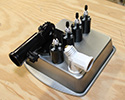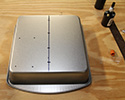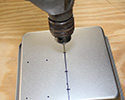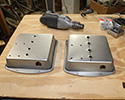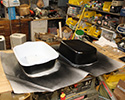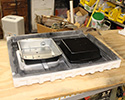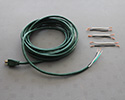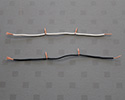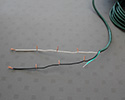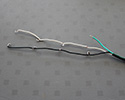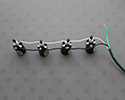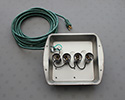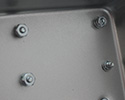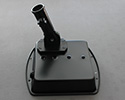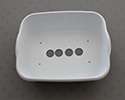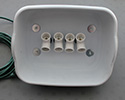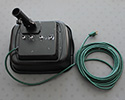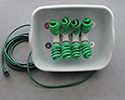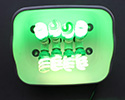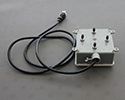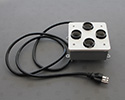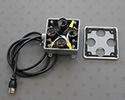Dr. V.'s Musings
February 27, 2014
DIY Lighting
480 Watt Equivalent Photo / Video Green-Screen Lamp
In photography and video one of the places you can easily save a lot of money with Do-It-Yourself making is lighting. This project grew out of my desire to improve the quality of the green-screen work we're doing in the classroom. One of the keys to green screen (pardun the pun) is in lighting the green screen well. So I wanted to build a pair of lights just for the green screen. In order to improve the "greenness" of my budget green screen¹ I opted for green "party" bulbs. You could, of course, use "daylight" or any other compact fluorescent bulbs if you wanted to use this lamp design to light your subject instead of a green screen.
Let's start with the parts list:
| Quantity | Item | Price Each | Subtotal | Vendor | |
|---|---|---|---|---|---|
| 1 | 7" Square Cake Pan | $1.00 | $1.00 | Dollar Tree | 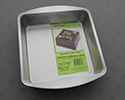 |
| 1 | 8 Quart Dish Pan | $1.00 | $1.00 | Dollar Tree | 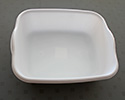 |
| 4 | Bottom Turn Knob Socket | $3.28 | $13.12 | Home Depot |  |
| 4 | Double Socket Lamp Adapter | $2.48 | $9.92 | Home Depot |  |
| 1 | Metal Flag Bracket | $10.98 | $10.98 | Lowes | 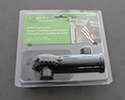 |
| 1 | Black Spray Paint | $4.34 | $4.34 | Walmart | 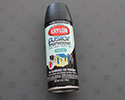 |
| 8 | Compact Fluorescent Green Party Bulbs | $4.98 | $39.84 | Home Depot | 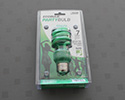 |
| 1 | Umbrella | $3.99 | $3.99 | Ollie’s Bargain Outlet |  |
| Total Cost Per Lamp: | $84.19 | ||||
(Compare with http://www.shopwise2000.com/photo-videoflourescentbanktwolamps.aspx for $369.00)
These are the prices I paid at the stores listed in early 2014 in Rochester, New York. Prices and availability may vary in your area. Note that almost half the total price is the bulbs themselves. I suspect that you could get white bulbs for significantly less. Also, I have noticed over the years that white umbrellas are something of a rarity outside of camera shops (where they are considerably more expensive ;-) so if you ever see any you may wish to pick them up and decide later whether or not you want to build your own lights.
In addition to the above I used miscellaneous nuts, bolts, washers, etc. I also used an old extension cord that had been cut in half by the lawn mower (oops) instead of buying a cord. Feel free to improvise with whatever you have in your workshop!
I made two lamps at once to save some time. The paint was more than enough for both lamps so if you build two lamps that cost is half. And I did things like drilled both pans nested together to save having to measure and mark each one separately.
Layout & Drilling
I began by playing with the components, getting a rough idea of where they'll fit, then worked out actual measurements from that. Then I marked out exactly where holes need to be drilled.
I like to begin by drilling small pilot holes. This helps prevent the larger drill bits from skipping across the surface of the metal. When possible I nested the pans and drilled them together so that I didn't have to measure and mark both.
Paint
Black spray paint prevents light from spilling through the white plastic of the dish pans. Dollar Tree used to have black dishpans as well as other colors beside white. Had they had black I would have simply bought an extra dispan and nested them. I also considered nesting a third (removable) green dishpan to enhance the greenness for my application, but all that was available was white.
Painting the baking pans eliminates unwanted reflections which can ruin a shoot. And the black looks nice. I bought the flagpole holders in black because I knew I was going to paint the rest black so this saved me having to paint them. You may be able to find less expensive plastic flagpole holders (I could not, but it was the middle of Winter), but you may want to paint them black to match. I also painted the bolt heads to match (and prevent paint from going through the holes).
Just an observation, but if you haven't noticed, spray paint has improved a lot over the years. This particular paint job went remarkably easily with a beautiful resulting finish.
Wiring
As I mentioned earlier, I had a used (and ruined) outdoor extension cord on hand, so I repurposed that. I cut off about a foot and stripped off the outer sheath to get enough wire for connecting all the sockets in parallel inside the cake pan. Here are all the wires cut and stripped.
If you've never done any electrical wiring, then you need to know that the black wires are "hot." That is, they are carrying the electrical current from the power source.
The white wires are "neutral." They do not carry any current unless the circuit is complete (light is on). Then they carry the current back to the power source. The green wire is "ground" and is physically attached to the earth. In your circuit breaker pannel the neutral and ground are connected. In the photo to the right you can see that I have attached all the short wires by twisting the stripped ends together.
And here I have attached them to the power cord. Make sure you connect black to black, white to white, and green to green. (In some electrical circuits the ground wire is bare copper, not green.)
In this photo you can see that I curled the twisted ends and soldered them. The solder makes for a stronger, better electrical connection and prevents loose strands which might cause a short circuit. They are curled because they will be fastened to the sockets with screws. Curl the wires clockwise so that when the screw is tightened clockwise it won't force the wire out from under the screw head.
Here the wires are attached to the sockets. The sockets will have two different colored screws. The brass screws are "hot" and should be attached to the black wire. The silver screws are neutral and should be attached to the white wire.
I attached the green ground wire to the screw on the strain relief attached to the pan so that everything metal will be grounded. You can test fit the sockets at this point, but do not attach them until after the twin bulb adapters have been screwed in.
I attached the flag pole holder (which we will use to attach the light to a light stand - purchased or home-made) with four bolts. Notice that on each bolt I used a flat washer (because the cake pan metal is thin) and a lock washer (so that the bolts won't loosen over time).
Here you can see the mounted holder.
Carefully drill four holes in the bottom of the dish pan to allow the sockets to fit through.
Here you can see that the adapters have been installed in the sockets and the cake pan has been bolted to the bottom of the dish pan. Note the use of fender washers. The dishpan plastic is thin and cracks easily, so these large washers distribute the force of the bolts over a larger area to help prevent strain.
Here is the back of the assembled light. While I was impressed with the ease of spray painting earlier, I was dismayed at how easily it scratched off of the cake pan while assembling the light. This may be my own fault, as I painted the new pans without first wiping them down with laquer thinner or some other solvent and the new pans were likely coated with something to prevent them rusting.
Here is the front view of the assembled light with the compact fluorescent bulbs installed. Be careful installing them as it is a tight fit and they are fragile. Always hold the bulbs by their bases while screwing them in.
And here it is with the bulbs lit! Because each socket has its own switch you can easily control how much light in 25% increments.
Umbrella
I'm still working out the details of how I want to attach the umbrellas and will add that here when it's done. I have a good idea, using some inexpensive parts from Home Depot.
Old Homemade Light I'm Canibalizing for Parts to Make Second Light:
Here is a four socket light I made a few years ago using a plastic outdoor electrical box. I'm disassembling it and reusing the sockets and wiring in my second light.
¹An object is green if it reflects light in the green wavelengths and absorbs other wavelengths. Since my green screen fabric is not as pure green as I would like, it is reflecting some other wavelengths — notably yellows. By illuminating it with primarily green light, I am hoping to reduce the amount of other wavelengths reflected and so make the cloth appear greener to the keying software used to make the green screen transparant.
